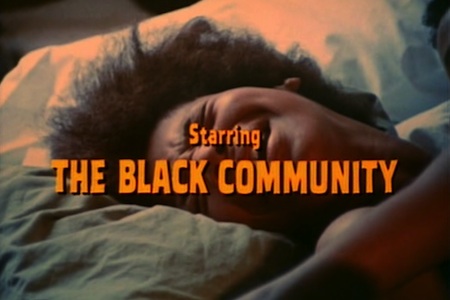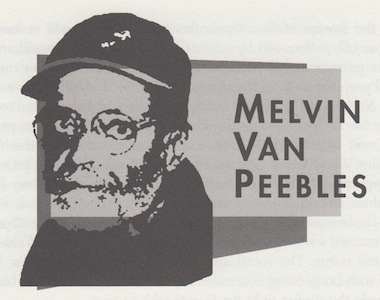Born: August 21, 1932, Chicago, IL
Here they come, an endless row of black filmmakers, charging up the road.
—Melvin Van Peebles
Like the main character in his first film, Watermelon Man (1970), director Melvin Van Peebles woke up one day and realized he was black. After writing screenplays in Beat-era San Francisco and bohemian France, Van Peebles ended up in Hollywood working on scripts with black themes. Disgusted with their lack of authenticity, Van Peebles saw an opportunity.
With a $50,000 loan from comedian Bill Cosby and a paycheck from his directorial debut, thirty-eight-year-old Van Peebles scraped together $500,000 and took just nineteen days to shoot a gritty, angry independent film that would become a cultural landmark. Sweet Sweetback’s Baadasssss Song (1971), filmed in Watts, created something revolutionary—a new black cinema.
Rife with sexual themes, graphic violence and vulgarity, Sweetback received an X rating from an all-white panel of the MPAA upon its release. Of the two theaters in the country that booked it, one deleted scenes from the movie. Enraged, Van Peebles sued and got the film restored to its original form in a highly publicized federal case. The publicity paid off. Black Americans flocked to see Sweetback. Black Panther Huey Newton hailed it as a “spiritual” masterpiece. Sweetback became the hottest film in the country, taking in just over $14 million, and Van Peebles was lionized as the soul of black popular culture.
Before the release of Sweetback, the depiction of blacks in motion pictures was largely influenced by white filmmakers, who, in small and subtle ways, often perpetuated stereotypes through sheer disregard or unwittingly reinforced prejudices. Over the decades since D.W. Griffith’s overtly racist The Birth of a Nation (1915), several black filmmakers had attempted to counter these negative images. The greatest effort in this area was the pioneering work of Oscar Micheaux, an African American filmmaker active for three decades after World War I. The son of former slaves, Micheaux provided significant opportunities for black actors and craftsmen, and history has since recorded him among the most significant, albeit controversial, figures in reshaping the image of blacks in popular culture. Despite these efforts, black cinema remained a segregated part of the film industry and was relegated to underground status. The social and political legacy of the 1960s, however, combined with burgeoning economical and cultural power in the black community, made the timing right for Sweetback’s success.
To Hollywood, Sweetback had another message: blacks would pay to see black films. The exploitation had begun. Releasing Shaft in late 1971, MGM turned a cool $20 million profit (Richard Roundtree, its star, made just $13,500). Sweetback had introduced a new market segment to film studios, much as Easy Rider (1969) had unearthed the commercial potential of youth-oriented films.
Van Peebles’s film shockingly illuminated a cultural gap between blacks and whites. Typical “Blaxploitation” films contain bleak settings, militant protagonists, police brutality and inexhaustible sexual appetites, usually backed by a soundtrack containing a healthy dose of electric funk. Van Peebles encouraged critics to view black films as foreign films, with a language and rituals unknown to white America. Many of the film’s detractors, including prominent members of the civil rights movement, argued that these Blaxploitation films trivialized the problems of drugs, misogyny and violence that afflicted urban centers in the seventies, but Van Peebles defended the angry message of the film as reflecting the true sentiment of African Americans.
After Sweetback, Gordon Parks and Sidney Poitier suddenly found financing for films. Television shows echoed their successes; the music industry mimicked their soundtracks. The movement opened doors for black actors, producers and directors. Within a year, the market was flooded with sixty Blaxploitation movies, and many of them blatantly copied Sweetback’s dialogue, fashion, music and themes. From action films like Superfly (1972), Foxy Brown (1974), Dolemite (1975) and Death Force (1978), a fresh batch of new stars emerged—Pam Grier, Jayne and Leon Isaac Kennedy, Rudy Ray Moore. An entire subgenre of black films contributed entries in horror, western, comedy and musicals: Black Caesar (1973), Blacula (1972), Blackenstein (1973), Black Belt Jones (1974) and Avenging Disco Godfather (1976), to name a few. These films were often campy and uninspired, but they reinforced Van Peebles’s contention that black audiences would support any enterprise that let them see themselves reflected in mainstream popular culture. Actor Ossie Davis would sum it up by saying, “Seems to me there’s a lot of money in just being black these days.”
Resurgent interest in the Blaxploitation genre sparked spoofs and sequels, including I’m Gonna Git You Sucka! (1988) and The Return of Superfly (1990), and director Quentin Tarantino nostalgically borrowed the look, feel and stars of the era in Jackie Brown (1997). More serious contributors, primarily Spike Lee, would later move black films far beyond stereotypical exploitation but credit Melvin Van Peebles for dramatically changing the face of film for an entire generation.
To read all the republished articles from ‘The Film 100,’ go to Reintroducing the Film 100 here on Keyframe.





